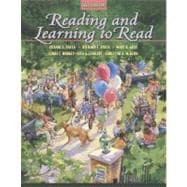This pioneering text, Reading and Learning to Read, Sixth Edition, emphasizes comprehensive reading instruction and remains an active learning tool that encourages future teachers to teach reading in ways that are both meaningful and reflective.
The authors of this market-leading text continue to promote a contemporary, comprehensive approach to teaching reading and writing with an emphasis on research-based best practice, integrating technology, and accommodating the needs of diverse and struggling learners. This edition maintains its focus on meeting standards—an increasingly critical topic—in new boxes connecting chapter content with standards and assessment, as well as in a wealth of practical examples and references that exemplify the IRA Standards for Reading Professionals.
TAKE A PEEK INSIDE THE SIXTH EDITION!
- “Step-by-Step Lessons” provide a range of mini lessons that can be transferred directly to the classroom.
- What About Standards and Assessment? sections at the ends of Chapters 3 through 15 connect chapter content to the two most important topics in reading instruction today—meeting standards and effectively assessing learning.
- New chapter order reflects the Reading First provision of No Child Left Behind.
- New margin icons—ELL Diversity—highlight material particularly relevant to teaching English language learners.
ONE REVIEWER SUMS IT UP!
“I believe it to offer an excellent balance between fundamental concepts guiding reading/language arts instruction and information describing “hands-on” strategies and techniques. The primary strengths of Reading and Learning to Read are the correlations with IRA Standards, the very colorful and appealing photos and figures in the artwork, the ease of reading, the organization of important information [in boxes and figures], and the handy chapter tools [chapter objectives, headings and subheadings, as well as the Teacher Action Research and the Related Websites]. The focus on Internet resources is up-to-date and relevant. In addition, the Appendices offer valuable resource information … What this text offers in the way of content that was deficient in other texts is the multitude of materials on word identification, building word concepts, and phonics instruction.”
Karen Samson, Chicago State University








